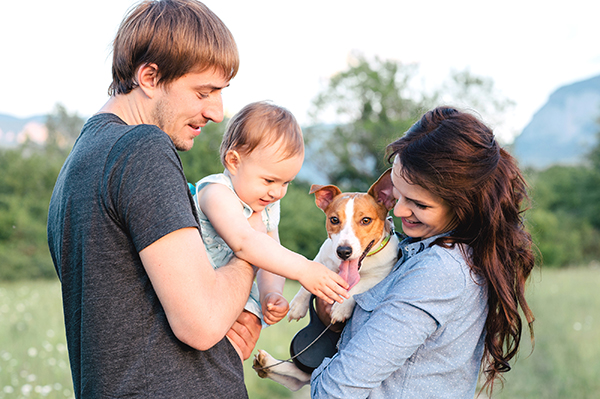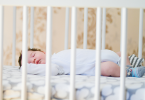No book, class, friend or family member can really prepare you for all the emotions, work and, yes, sleepless nights that come with having a baby.
And if you aren’t prepared? Think of how your dog or cat must feel.
Who is this little squirming, squawking creature who’s now taking up all of mom’s time and attention?
“It’s true for many of us: Our dog or cat or other pet are our first babies,” said Renee McCabe, injury prevention & SafeKids coordinator for SafeKids Greater Augusta. “But once the children come, it’s hard to maintain that status because you don’t have the time or the energy. It can be a big transition for your pet.”
But you can make that change a little easier, for both of you. And it starts during pregnancy.
Before the Baby Arrives
Once the baby comes, your routine is going to change pretty drastically overnight. While you’re still pregnant, as you start figuring out what the new routine will be, you can help your pet begin to adjust too. For example:
- As you set up the nursery, let your pet see you sitting in the chair you’ll use to nurse or feed your baby, and teach them not to jump up.
- Sometimes you’ll need to be in the nursery with the door closed. Practice that now to help prevent loud barking or meowing when you are desperate to get your newborn to sleep.
- Your fur-baby will see you holding a bundle almost constantly. It may feel silly, but hold a baby blanket wrapped around a towel or doll a few times and let your pet see you. Extra points if you add some baby lotion to the bundle so that your dog or cat gets familiar with the scent.
- Loud crying and other newborn noises will be the new background music to your lives. YouTube is a wealth of baby sounds, so crank up the volume to ensure your dog or cat isn’t surprised when the real thing happens.
- If you need to change where your dog sleeps or where your cat’s litter box is because of how close they are to the nursery, move them gradually so pets get used to the new location.
- Cats are notoriously independent, but if your dog isn’t trained to listen to your commands, it would be very helpful to really work on training before the baby comes. That might give you a little more control when you’re stuck in a chair for an hour breastfeeding while your dog is whining at your feet for you to come play.
- It’s tough to do, but about two or three weeks before the baby’s due, reduce the amount of time you spend with your pet. The worst thing you could do is to heap on the attention just before the baby comes, then have to shut it off once you’re consumed with taking care of a newborn.
Finally, as the due date approaches, definitely make plans to have someone on call to care for your dog or cat—preferably a caretaker they’re used to—once you’re ready to head to the hospital.
Bringing Baby Home
Even before you come home, send something special ahead first: A blanket, hat or onesie that your little one has worn, so that your pet can get a whiff of the new family member’s smell.
You may want to arrange for your pet to be home when you arrive—or for your pet to return after a few days so you can first get settled with your newborn. In either case, the greeting is important: Make sure that you welcome your pet alone, with plenty of love and attention. Then, introduce the baby. Don’t force it; just let your pet see the baby in your arms. If your pet seems open to it—and not overly excited—you can allow some gentle sniffing, but be sure you have a hand on a collar or leash.
The first six weeks after having a baby are intense, but do your best to focus at least a few minutes every day with your pet. Snuggle while the baby’s sleeping—you can even take a nap together—or if you have a sitter, go for a walk since the exercise and fresh air are good for both of you.
But remember, no matter how well behaved the pet, never leave your dog or cat alone with your baby. Even a loving pet who chooses to sleep near the baby’s head can make it harder for the baby to breathe since newborns can’t move their heads away. “Babies can also make sudden movements, which can scare or upset your pet, so you have to be vigilant,” said McCabe. “You never know how a pet might respond, even if they are familiar with your baby and have never shown signs of aggression before.”
Know the signs that your pet is upset or uncomfortable, including chewing up items around the house (if they don’t usually do this), having accidents, nervous pacing, excessive panting or other behavioral changes. You can talk to your vet or an animal trainer for tips to help your pet feel more comfortable. Growling or snapping of course are clear signs, and for many parents, that’s when they have to make the hard decision to find a new home for their pet.
As your baby grows older, make sure your childproofing includes protecting your pet’s food, water and toys. “Animals are territorial,” said McCabe, “so use child safety gates so prevent access to items that are important to your pet.”
From the Pet’s Point of View: Nugget’s Take
After all, animals are only doing what comes naturally to them. “It’s up to us to help train them but also to protect them,” said McCabe.
As the full-time therapy dog at the Children’s Hospital of Georgia, Nugget and her handler, child life specialist Harleigh Turner, interact with children of all ages. Turner is always careful to teach the children how to behave around animals, while also ensuring Nugget follows the guidelines she’s been taught during her intense training since puppyhood.
“I am always cognizant of Nugget’s position in relation to the child,” said Turner. “I purposefully position Nugget with her back facing the child; this way I can ensure no little fingers find a nose, mouth or eye to poke or injure Nugget. I also never take my hands off of Nugget to ensure I am prepared to separate her from a child who may not be engaging in the best way. I often use both hands to pet her face or ears, or I have Nugget’s head positioned in my armpit and I am wrapped around rubbing her shoulders. I never allow anyone to climb onto Nugget, sit or bounce on her back, pull on her ears, fur, tail or feet, or engage with Nugget during a meal or snack.”
These are the exact same tactics Turner uses when Nugget is at home, playing with her four nephews and nieces, ages 4, 2, 1 and 10 months.
“It takes practice and preparation,” said McCabe. “It’s an adjustment period for both you as the mom and for your pet as you get ready to welcome this new member of the family.”




